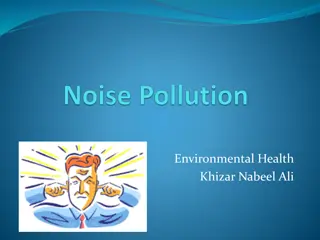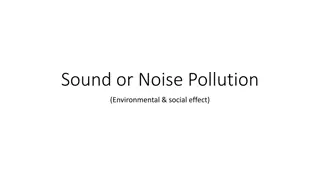Understanding Thermal Pollution and Its Sources
Thermal pollution is the detrimental effect of heated effluents discharged by power plants on aquatic and terrestrial ecosystems. This pollution occurs when the temperature of water bodies rises significantly due to human activities, leading to a reduction in dissolved oxygen and impacting aquatic life. Sources include nuclear power plants, coal-fired power plants, industrial effluents, and hydroelectric power generation. The discharge of heated water can harm aquatic flora and fauna, disrupt ecosystems, and contribute to the spread of diseases.
Download Presentation

Please find below an Image/Link to download the presentation.
The content on the website is provided AS IS for your information and personal use only. It may not be sold, licensed, or shared on other websites without obtaining consent from the author. Download presentation by click this link. If you encounter any issues during the download, it is possible that the publisher has removed the file from their server.
E N D
Presentation Transcript
THERMAL POLLUTION Dr. Vinod K.V.
THERMAL POLLUTION effect of heated effluents discharged by various power plants It denotes the impairment of quality a & deterioration of aquatic & terrestrial ecosystems Heated effluents are discharged at a temperature 8-100C higher than the temp. of intake waters, which reduces the concentration of D.O.
Definition The warming up of an aquatic system to the point where desirable organisms are adversely affected Addition of excess undesirable heat to water that makes it harmful to man, animal, plant or aquatic life or otherwise causes significant dangers to the normal activities of aquatic communities in water Heated effluents either from natural or man made sources, contaminated with water supplies, may be harmful to life because of their toxicity, reduction in dissolved oxygen, aesthetically unsuitable & spread diseases
SOURCES Nuclear power plants Nuclear power plants including drainage from hospitals, institutes, nuclear exp. & explosions, reactors discharge heated water with radionuclides 100C higher than the coolant receptor Severely affect aquatic flora & fauna
Coal fired power plants Major source of thermal pollution Heated coils are cooled with water from nearby lake or river and discharge hot water back to the receptor 150C b/w effluent & water body
Industrial effluents Industries generating electricity (coal or nuclear power sources), textile, paper and pulp, sugar... Turbo generators release effluents with temp. 5-90C
Hydroelectric power Domestic & Municipal sewage discharged to rivers, lakes & canals with or without treatment Raise temperature Organic matter present utilise D.O
EFFECTS Reduction in dissolved oxygen D.O decrease with increase in temp. Eg. D.O-14.6 ppm @ 320F, 6.6 ppm @ 640F Affect aquatic biota
Change in water properties physical & chemical change vapour pressure increases, density decreases, viscosity & solubility of gases increases the settling speed of suspended particles affect food supply
Increase in toxicity Increases toxicity of poison present in water Eg. 100C rise in temp. doubles the toxic effect of KCN
Interference with biological activities Temp. is vital for physiological, metab., biochemical & overall development of aquatic organisms Sharp changes in temp. are often destructive Interference in reproduction In fishes nest building, spawning, hatching, migration & reproduction depends on optimum temp. Eg. Max. temp at which lake trout spawn is 8.90C
Variation in reproduction rate Changes in metabolic rate Increased vulnerability to diseases Invasion to destructive organisms Undesirable change in algae population Biochemical Oxygen demand Destruction of organisms in cold water Effect on marine life Effect on bacteria
CONTROL OF THERMAL POLLUTION Cooling Ponds Used for the dissipation of heat Water from the condenser is stored in earthen ponds where natural evaporation brings down temp. Water is re circulated again























